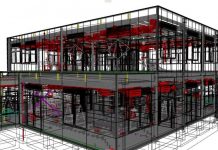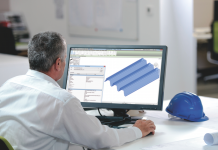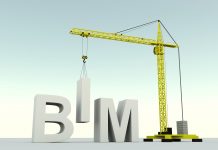Karl Redmond, member of BIM4HEALTH and Director of BIM4SME details how the IoT, big data and the BIM agenda can help shape a digital NHS that is fit for the future
The NHS has the potential to be a world leader in healthcare big data – it possesses largely centralised records dating back to the organisation’s inception in the 1940s. There is clearly a greater demand for it (NHS) to capitalise on the opportunities the digital information revolution presents. As Lord Carter points out in his Interim Review of Operational Productivity in the NHS, the ability to analyse data appropriately can pinpoint waste and thus hopefully help slow the accelerating cost of healthcare across the organisation. This is a start, but why not use the Internet of Things (IoT), the digital revolution and the data to identify existing provisions, inefficiencies, and optimise under-utilised opportunities and the potential leverage points for Trusts to create capital and revenue for new facilities, existing estates and reconfiguration solutions?
The NHS’s track-record in handling big IT, let alone big data projects, is hardly an exemplary one but there is enormous potential for the NHS to save money in its day-to-day operations and in areas that don’t necessarily involve any encroachment of patient privacy. Procurement is one area where NHS Estates and facilities managers must achieve financial improvements and structured, uniformly provided data can not only provide cost savings but help plan and run services more efficiently as well as help meet increasing compliance requirements. Without consistent and reliable data, facilities managers and estate heads will forever be reacting and playing catch up in terms of efficiency and effectiveness of the operation.
Official ERIC (Estates Return Information Collection) figures, providing data about estates and facilities in NHS trusts, which collectively costs an annual £7.3bn to run and extends back to 1999 – are sometimes viewed with skepticism by some, but the volume of data is being analysed to help identify potential savings.
Trusts have been traditionally guarded about their data, apart from that which they must statutorily provide, something that is increasing exponentially under new compliance requirements. Developing projects to capture data, both in terms of size and complexity, to then to map and interpret it is problematic, but not unachievable. Most NHS Trusts have recognised the considerable and rapid advances in hardware and software technologies coupled with ‘Big Data’ and IoT agendas. However, using the data intelligently is more complex and must be coupled with the issue of security, which is ever present and won’t stop progress, but will need careful monitoring.
Health departments and organisations, whether public or private, need partners that can cover end-to-end solutions from Government Soft Landings, post occupancy evaluation, and asset connectivity, to IoT cloud, big-data, Building Information Modelling (BIM – see BIM4Health, http://www.bim4health.org/ for further information) & analytical expertise. This is essential if we are to apply the right level of intelligence that will improve asset longevity, performance, compliance, cost benefit efficiency targets, and maximise usage. We also need it to reduce maintenance, repair, operations (MRO) costs, inventory costs and procurement costs. There is no single entity able to deliver such a significant ask alone, but steps have been taken to develop groups, public and private, which will be encouraged to continue to collaborate, share expertise and grow throughout 2016 and beyond. The IoT, big data and BIM agenda will not stop, but it must be moulded for the benefit of clients before it is hijacked by short-term thinking.
The healthcare sector needs to fully engage or face being left behind, leaving us all, along with future generations, worse off.
Can the IoT drive innovation in the healthcare estate?
Yes. As an extension of the Digital Revolution, the IoT offers particular relevance to health providers. Monitoring actively and passively can provide insights into the activity and operation of healthcare estates. The data collected can feed a myriad of solutions such as predictive analytics regarding an asset or component, as well as estates. Privacy of patients is, of course, of paramount importance, and safeguards and security can be built in to services. Together, the Digital Health Revolution and the IoT offer a dynamic interplay to revolutionise our healthcare environments, reduce costs and improve quality, with the BIM agenda playing a minor but critical link on-going.
The NHS has most of the data required to achieve great things as well as having the desire and the willingness, from some, to drive this agenda. All organisations need to be able to share data, despite the ever-present need to hold on to intellectual property, the promotion of best practice will increasingly rely on organisations sharing big data. However, it is important to ensure uniformity and accuracy. It is all very well pushing data at each other but if that data is rubbish, then what is the point? The culture has to change and action taken before the issue is taken out of the hands of those who want to deliver the right patient outcomes and given to those whose primary objective is not healthcare.
Can we work towards smarter and intelligent NHS buildings?
Yes. An example of how the IoT can help towards the development of intelligent buildings is the rapid development seen in the private sector. A number of large global entities from the UK, Germany and USA have come together with a view to creating a high volume asset data hub designed to provide clients with information on specific aims and objectives relating to the NHS estate that align with those of the clinical healthcare offering. The collaborative group with their combined expertise and technological offering will enable facilities managers and others to stay connected to their assets, wherever they are.
The latest ‘App’ technology brings relevant metrics and tools to resolve issues directly to mobile devices, helping to improve efficiency and safety on a number of fronts. Big data analytics gives managers the ability to receive alerts, monitor performance, create cost benefit reports, assess compliance and refine operations proactively. It will also enable estate and facilities managers to respond faster to situations, whether planned or unplanned.
Can we rationalise the healthcare estate?
Yes. With the UK Government BIM Task Group and associated BIM4 sector groups looking to develop BIM Level 3 in 2016, it would seem that a more client focused approach will emerge, finally, hopefully, fingers crossed, from the initiative. The claim (I hope it becomes reality) is that BIM Level 3 will be the approach that connects the data from start to finish, which in turn will help to create end-to-end efficiencies. The process at BIM Level 3 along with its data will be seen as a single source of the truth, stored in a database in the cloud and accessible by all involved, especially clients. If this process can be perfected it can offer everyone the opportunity to collaborate openly and enable real building life-cycle management to take off, which will also require product life-cycle management understanding. The process will help break down the current silos seen in the sector and within healthcare organisations and provide facilities teams and estates managers with true as-built models (inclusive of all ‘value engineering’ changes throughout the process) from which to work with.
The volume of data within the process, supported by IoT, which can be captured, monitored, examined, analysed and reported, can be fed back into board level strategies for outline and full business case plans. This all aides in the key decision making regarding the entire estates planning process, specific asset optimisation, utilisation and possible rationalisation, and objectives for improved patient care. NB: Don’t sell your asset unless you really have to, it must be the right course of action for your growing patient demands – try reconfiguring.
Could we optimise how services are being provided as a result of IoT?
Yes. Industrialisation and standardisation is common in most other sectors and only relatively recently has this been seen in the construction and built environment sector. With further understanding from the client around the BIM agenda, including accurate assessment of when, how, why and what is needed to support specific healthcare economies requirements, IoT, with industrialisation techniques will increase sustainability, optimise operations, lower costs and improve compliance. The complexity of facilities management and estates procurement means that organisations can spend a disproportionate amount of time sourcing and purchasing items or services that may be of relatively small value, both individually and in total. These procurement process costs are largely invisible, and, therefore, tend to be underestimated or even ignored, but can be significant. Through the development of a transparent ‘end-to-end’ processes, supported by the billions of smart devices in the IoT, delivering valuable insights as a result of the data they capture, will give facilities and estates managers the ability to rapidly change and optimise the service they provide.
Can we maximise use of facilities & evidence based design in healthcare facilities?
Yes. If you can begin to imagine the massive amount of data that is available via IoT, alongside the cloudbased analytical expertise that exists, coupled with the ability to develop end-to-end data processes as outline above, then learning lessons from the holistic data reporting should be easier to achieve. This holistic process and thinking does not have a start or an end, it is continuous, therefore, where you start should not matter. It will enable facilities and estates managers to tackle existing facilities as well as new build programs. Continuous lessons, refinements, benchmarking through data analyses and reporting will highlight the availability and suitability (supply) of physical assets needed to house clinical care delivery that will ultimately benefit unique, local, regional and national healthcare demographic (demand) groupings.
Once an understanding of the ‘supply and demand’ is achieved, facilities and estates managers will be better placed to help (re)design healthcare facilities and support associated clinical services (gap). All of which will be based on data that will increase in its accuracy, relevance and effective pin pointing of resources/money (demand – supply = gap). It may lead to more facilities and estates managers having a seat at the boardroom table as a result of the significant impact their evidenced based solutions can bring if understood by all.
Can we improve the staff/patient environment and building automation?
Yes. The introduction of cost effective devices giving and receiving information via IoT from the cloud will not only improve clinical team/providers’ experience, it will make them more efficient when analysing the utilisation of the space in which they operate. The same devices delivering intelligent building information will also aid and benefit the growing and demanding expectations of patients and their experience whilst in hospital. Privacy of patients is, of course, of paramount importance, safeguards and security can be built into systems to ensure the data is there to serve, without encroaching into strictly regulated information zones. The connectivity of all the above to a range of additional options including, activity data bases, premises assurance and compliance models should be achievable when possible.
Existing healthcare operational ‘dash board systems’ with various options, not just estates and facilities, can be incorporated or utilised to support gradual intelligent smart building development. The aim would be to develop cost, compliance, durability, life cycle, benchmarking data and reports that can help to reduce costs whilst increasing performance and quality. There are existing groups, public and private, involved in current projects wanting to offer facilities and estates managers – who demand quality, performance, longevity, transparency, adaptability (especially with existing systems) – the ability to deliver more with less. Developing a holistic approach, aided by the above, will enable facilities and estates managers with their primary suppliers and supply chains to collaborate and promote transparent engagement throughout the entire asset life cycle for the betterment of staff and patients.
Can this be achieved by embracing public, private & people partnerships for NHS estates and facilities?
Yes. However, this comes with a word of caution. The technology is available and is rapidly improving and advancing, seemingly daily. The data offering is massive, instant, more reliable, robust and effective. It can also be refined and analysed faster to produce results and conclusions for those who need it. Evidence, transparency, collaboration and culture change are just some of the considerations and watch-words to keep in mind…now the caution….
Not all involved in the public sector want change, some fear it may expose what gaps exist in longstanding systems and processes, but change is needed. Some of those involved in the private sector can ‘sell snow to an Eskimo’, and don’t always have the interests of the patient at the centre of their aims and objectives. Lastly, people – and I include politicians in this definition – are fickle, lack understanding of the issues within the massive NHS structure (does anyone?), and are only really interested in scoring political points off each other rather than fully engaging to help a service which we all rely upon.
Finding the right partner and partnership is key – with the relevant structure, right governance, fair outputs arrangements, based on deliverable and manageable programs that tackle both short-term and long-term agendas – with one ultimately dovetailing with the other. The public sector does have a choice on how it engages in the unstoppable IoT, BIM, Digital Revolution agenda – it either, does or it doesn’t. Those who don’t will see the ‘Sword of Damocles’ – alternatively known as ‘austerity’ – with the imminent and ever-present peril being faced by those in all positions in the NHS. The private sector will benefit from ‘sitting on the same side of the negotiating table as the client’ – these benefits come in the form of long term, trusted commercial relationships, de-risking returns for the business and its shareholders. There are many promising initiatives involving IoT, BIM, big data and the digital revolution that are already producing results, but leadership regarding data sharing across the NHS is generally fragmented in approach. A less siloed, more joined-up approach is urgently needed.
Finally, the people, again including politicians, will hopefully see reform, efficiencies, improved quality, better clinical services, modern effective facilities and all on a financially viable footing with transparency running through the whole collaborative system. By combining the strengths, knowledge, skills and expertise of multiple partners and stakeholders – across both private and public sector – the ingredients for an effective and robust strategy to improve our healthcare systems can be created.
Is this too much to ask of those involved in our precious National Health Service? I hope not. ■
Karl Redmond MSc, has over 20 years of property experience ranging from estate rationalisation, finance, strategic/commercial planning and analysis. He is a Director of the UK BIM4SME and member of UK BIM4HEALTH group, endorsed by Cabinet Office. He is also a Fellow of the Leeds Sustainability Institute and is pursuing a Ph.D. with Leeds Beckett University with a focus on NHS Estates and Patient Pathways via the digitisation of the built environment, BIM and the ‘big data’ agenda.
. . . . . . . . . . . . . . . . . . . . . . . . . . . . . . . . . . . . . . . . . . . . . .
Karl Redmond
Director of BIM4SME and member of BIM4HEALTH
0113 350 0000













